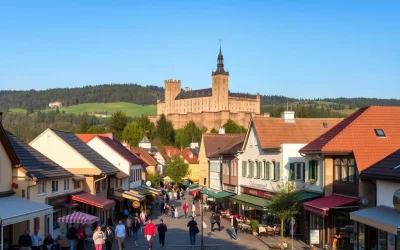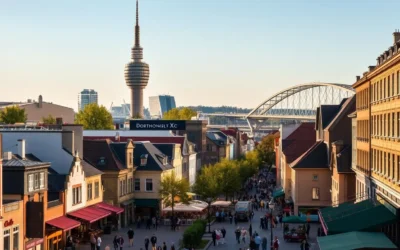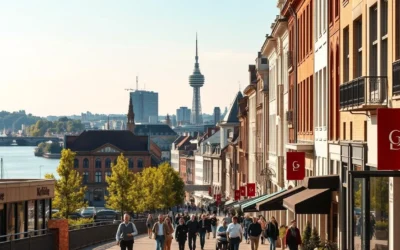✓ Accommodations ✓ Flights ✓ Rental Cars
Welcome to a vibrant region where language plays a central role in shaping daily life. Here, German is the primary language, spoken by about 95% of the population. But this state is more than just a place where German is dominant—it’s a melting pot of cultures and dialects.
From native dialects to immigrant languages like Turkish, Arabic, and Polish, the region thrives on its linguistic variety. This blend of tongues adds a unique flavor to the culture, making it a fascinating area to explore. Whether you’re in a bustling city or a quiet town, you’ll hear a mix of voices that tell the story of this diverse place.
Ready to dive deeper into the official and widely spoken languages here? Let’s uncover the rich tapestry of communication that defines this remarkable area.
Introduction to North Rhine-Westphalia and Its Language Landscape
Step into a region where history and culture shape its language. This area is a fascinating blend of traditions and modern influences, creating a unique linguistic identity. From ancient dialects to the languages brought by immigrant communities, the region thrives on its diversity.
Cultural Diversity in the Region
The culture here is deeply rooted in its long history. Over the years, the region has welcomed people from different parts of the world, enriching its linguistic tapestry. Today, you’ll hear a mix of traditional dialects and modern tongues, reflecting the area’s dynamic character.
This blend of languages isn’t just about communication—it’s a reflection of the region’s identity. Whether in a bustling city or a quiet town, the variety of voices you encounter tells a story of unity in diversity.
Historical Background of Languages
The evolution of language in this state is a journey through time. From the early dialects spoken centuries ago to the influences of migration, the region’s linguistic landscape has continually evolved. This history has shaped the way people communicate today.
Understanding this background helps you appreciate the richness of the area’s language dynamics. It’s not just about words—it’s about the stories they carry and the connections they create.
The Role of German as the Official Language
Discover the heart of communication in this dynamic area. German stands as the cornerstone of daily life, connecting people across the state. Whether in education, government, or media, Standard German, or Hochdeutsch, is the primary tool for official communication.
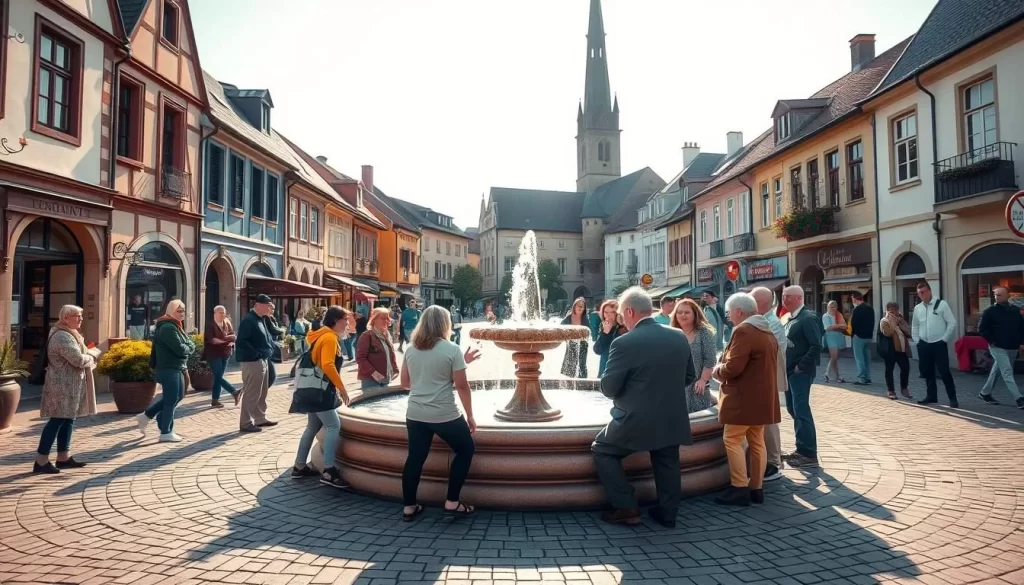
This language is more than just a means of communication—it’s a bridge between tradition and modernity. In schools, students learn Standard German, ensuring a unified way of speaking. In the media, it’s the voice that reaches every corner of the region.
Standard German and Regional Dialects
While Standard German dominates official settings, regional dialects add a unique flavor to everyday life. These dialects are more than just variations—they’re a reflection of local culture and history. From the Kölsch spoken in Cologne to the Plattdeutsch heard in rural areas, each dialect tells a story.
About 95% of the population speaks German or its dialects. This blend of Standard German and regional variations creates a rich linguistic tapestry. It’s a way for people to connect with their roots while embracing modern communication.
“Dialects are the soul of a place—they carry the essence of its people.”
These dialects also provide a sense of identity and belonging. For many, speaking a regional dialect is a way to feel at home in a rapidly changing world. They’re a reminder of the region’s deep history and cultural diversity.
As you explore this area, take a moment to appreciate the linguistic precision behind everyday conversations. Whether it’s Standard German or a local dialect, each word carries the weight of tradition and the promise of connection.
North Rhine-Westphalia, Germany: Official and widely spoken languages
Immerse yourself in the rich tapestry of languages found here. This state is a hub of communication, where German is just the beginning. The region thrives on its linguistic diversity, shaped by centuries of history and modern influences.
Major Languages Spoken in NRW
While German is the primary language, the region is home to a variety of other tongues. Immigrant communities have brought their native languages, creating a vibrant mix. Here are some of the most widely spoken languages:
| Language | Percentage of Speakers |
|---|---|
| Turkish | 5% |
| Arabic | 3% |
| Polish | 2% |
| Russian | 1.5% |
| Dutch | 1% |
These languages add depth to the culture and make the state a fascinating place to explore. In cities like Cologne and Düsseldorf, you’ll hear a blend of voices that reflect this diversity.
Impact of Immigration on Language Diversity
Immigration has played a key role in shaping the linguistic landscape. Over the years, people from different parts of the world have brought their languages and traditions. This has enriched the region’s communication and created a dynamic environment.
For example, Turkish is one of the most spoken immigrant languages, with a significant community in the state. Similarly, Arabic and Polish are widely heard in certain areas. This blend of traditional and immigrant languages fosters a sense of unity and connection.
Cultural integration has also helped promote language diversity. Schools and community programs encourage multilingualism, making it easier for people to connect across cultures. This approach strengthens the social fabric and enhances community interactions.
As you explore this region, take a moment to appreciate the voices around you. Each language tells a story, adding to the rich tapestry of this remarkable place.
English Proficiency in North Rhine-Westphalia and Beyond
English has become a cornerstone of communication in this dynamic region. It’s not just a language—it’s a bridge connecting people, businesses, and cultures. Here, English proficiency is a key skill, opening doors to opportunities in education, work, and global interactions.
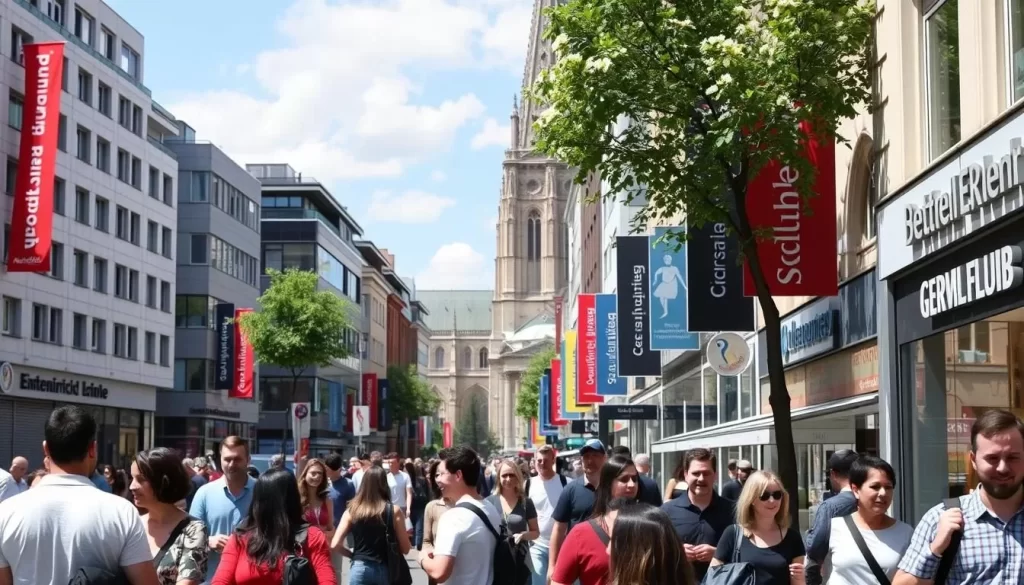
According to the EF English Proficiency Index, this state ranks highest in the country, with an impressive score of 619. This reflects the strong emphasis on learning English, especially among younger generations and in urban areas.
Regional Variations in English Skills
English skills vary across the region. Urban centers like Cologne and Düsseldorf lead the way, with many residents fluent in English. In contrast, rural areas may have lower proficiency levels. These differences highlight the impact of education and exposure to international environments.
City-Level English Proficiency Highlights
Certain cities stand out for their exceptional English skills. For example:
- Karlsruhe: Known for its tech industry, English is widely spoken here.
- Cologne: A cultural hub where English is common in business and tourism.
- Düsseldorf: With its international community, English is a daily language for many.
These cities demonstrate how English proficiency enhances global connections. It’s not just about communication—it’s about building relationships and fostering innovation.
High English skills also benefit the local economy. Companies in industries like tech, finance, and tourism often require employees to speak English. This creates more job opportunities and attracts international talent.
In education, English is a priority. Many schools offer bilingual programs, and universities provide English-taught courses. This prepares students for a globalized world and gives them a competitive edge.
As you explore this region, you’ll notice how English connects the local with the global. It’s a skill that empowers individuals and strengthens communities. Whether you’re visiting or planning to stay, English proficiency is a valuable asset here.
Minority Languages and Regional Dialects in Germany
Explore the vibrant world of minority languages and regional dialects in Germany. These linguistic treasures are more than just ways to communicate—they are vital parts of the country’s cultural heritage. Preserving them ensures that unique traditions and identities continue to thrive.
Preservation Efforts Under the European Charter
Germany has taken significant steps to protect its minority languages and dialects. The European Charter for Regional or Minority Languages, ratified in 1998, provides a legal framework for their preservation. This charter requires states to implement at least 35 measures to promote these languages.
Every three years, Germany submits reports on its efforts to the Council of Europe. These reports highlight policies and initiatives aimed at supporting linguistic diversity. The goal is to ensure that minority languages remain a living part of the country’s culture.
Here are some of the minority languages protected under the charter:
| Language | Region |
|---|---|
| Danish | Schleswig-Holstein |
| Low German | Northern Germany |
| North Frisian | West Coast of Schleswig-Holstein |
| Sorbian | Saxony and Brandenburg |
These languages are not just spoken at home—they are integrated into public life. Schools, media, and government services support their use. This approach helps communities maintain their linguistic identity while fostering a sense of belonging.
Regional dialects also play a crucial role in enriching cultural understanding. They connect people to their roots and create a shared sense of history. Whether it’s Plattdeutsch in the north or Sorbian in the east, each dialect tells a story of the region’s past and present.
“Preserving minority languages is preserving the soul of a community.”
Government policies further support these efforts. In Schleswig-Holstein, for example, citizens can communicate with public administration in Danish, Frisian, or Low German. This ensures that minority language speakers feel valued and included.
As you explore Germany, take a moment to appreciate the linguistic diversity around you. Each language and dialect adds to the rich tapestry of the country’s culture. By valuing these voices, we help keep Germany’s heritage alive for future generations.
Language Education and Its Impact on Future Generations
Language education in this region is shaping the future of communication. Schools here are taking a structured approach to ensure students are prepared for a globalized world. From early childhood to higher education, the focus on multilingual learning is transforming how young people connect with others.

Foreign Language Curriculum in German Schools
In this area, foreign language classes start as early as age 5. English is a compulsory subject, and many schools also offer French, Spanish, or other languages. This early introduction helps students develop strong language skills that will benefit them throughout their lives.
For example, over 90% of students in this region learn English as their first foreign language. This focus on English proficiency ensures they can communicate effectively in a global context. It also opens doors to international opportunities in education and work.
Bilingual Programs and Their Benefits
Bilingual programs are another key feature of the education system here. These programs teach subjects in two languages, helping students become fluent in both. This approach not only improves language skills but also fosters cultural understanding.
Here are some benefits of bilingual education:
- Enhanced cognitive abilities and problem-solving skills.
- Improved job readiness in a competitive global market.
- Greater cultural integration and empathy for diverse communities.
Studies show that students in bilingual programs often outperform their peers in academic and professional settings. They are better equipped to navigate a multilingual world and contribute to their communities.
“Bilingual education is not just about learning two languages—it’s about understanding two cultures.”
As you explore this region, you’ll see how language education is preparing future generations for success. Whether in the classroom or the workplace, these skills are a valuable investment in their future.
The Historical Evolution of Germany’s Language Policies
The story of Germany’s language policies is a fascinating journey through time. From the Cold War era to today, these policies have shaped how people communicate across the state. Understanding this evolution gives you insight into the cultural and political forces that have influenced the region’s linguistic landscape.
East-West Divide in Language Trends
During the Cold War, Germany was divided into East and West, each with distinct language trends. In East Germany, Russian was heavily promoted as a second language due to political ties with the Soviet Union. Schools emphasized Russian proficiency, and it became a key part of the curriculum.
In contrast, West Germany focused on English as a bridge to the Western world. English was seen as essential for economic and cultural integration. This divide created two different linguistic identities within the same country.
| Aspect | East Germany | West Germany |
|---|---|---|
| Primary Second Language | Russian | English |
| Focus | Political alignment | Economic integration |
| Impact | Limited global reach | Enhanced global connections |
Post-Reunification Shifts and Global Influences
After reunification in 1990, Germany’s language policies underwent significant changes. English became the dominant second language nationwide, reflecting the country’s integration into the global economy. Schools shifted their focus to English proficiency, preparing students for international opportunities.
Globalization further influenced these policies. As Germany became a hub for international business and culture, the demand for English skills grew. Today, English proficiency is a key asset in the job market and education system.
This evolution highlights how historical events and global trends continue to shape Germany’s approach to language. It’s a reminder that language is not just a tool for communication—it’s a reflection of a nation’s identity and aspirations.
The Role of English in German Business Communication
In today’s globalized world, English has become a vital tool for business success in Germany. It’s not just a language—it’s a bridge connecting companies, employees, and international markets. Whether you’re in a bustling city like Berlin or a smaller town, English proficiency is a key skill for career growth.

About 56% of Germans speak English as a second language, making it one of the most widely used tools in the workplace. This proficiency is especially high in urban centers, where global companies thrive. For example, in cities like Munich and Frankfurt, English is often the primary language in multinational corporations.
Global Impact and Job Market Relevance
English plays a crucial role in Germany’s global business landscape. Many companies require employees to speak English, especially in industries like tech, finance, and tourism. This demand reflects the country’s integration into the global economy.
Here are some key points about English’s impact:
- Over 15% of job offers in major cities require English proficiency.
- Industries like IT and engineering prioritize bilingual employees.
- English skills can increase earning potential and open doors to international opportunities.
“Mastering English is not just about communication—it’s about unlocking global opportunities.”
For example, companies like Siemens and SAP rely heavily on English for internal and external communication. This trend highlights the importance of dual language skills for career advancement. By improving your English proficiency, you can position yourself as a valuable asset in the job market.
English also helps attract international business to Germany. Many foreign investors and partners prefer working with companies that use English as a common language. This makes it easier to build relationships and foster collaboration across borders.
As you navigate your professional journey, consider how English proficiency can enhance your career. Whether you’re aiming for a promotion or exploring new opportunities, this skill is a powerful tool for success in today’s interconnected world.
Cultural Benefits of Multilingualism Across Germany
Multilingualism is a powerful force that brings people closer, creating stronger bonds and richer cultural experiences. In this region, the ability to speak multiple languages fosters social integration and builds cohesive communities. It’s not just about communication—it’s about understanding and embracing diversity.
Multilingualism plays a key role in bridging gaps between different groups. When people can communicate in their native language, they feel valued and included. This sense of belonging strengthens community ties and promotes unity. In cities and rural areas alike, multilingualism enriches cultural interactions and creates a more open society.
Social Integration and Community Cohesion
One of the most significant benefits of multilingualism is its ability to foster social integration. When individuals can speak multiple languages, they connect more easily with others from diverse backgrounds. This builds trust and understanding, which are essential for community cohesion.
Cultural policies and community programs play a vital role in supporting multilingualism. For example, initiatives that encourage bilingual education or multicultural events help people appreciate different cultures. These efforts not only preserve linguistic diversity but also strengthen the social fabric of the state.
“Multilingualism is a bridge that connects hearts and minds across cultures.”
Personal growth is another advantage of being multilingual. It enhances cognitive abilities, improves problem-solving skills, and boosts confidence. For many, learning a new language is a way to explore new perspectives and broaden their horizons.
In both urban and rural areas, multilingualism brings social benefits. It helps people navigate diverse environments, fosters empathy, and promotes inclusivity. Whether you’re in a bustling city or a quiet town, the ability to speak multiple languages enriches your interactions and deepens your connections.
To learn more about how multilingual education supports social integration, check out this comprehensive resource.
Conclusion
Language shapes the way we connect, and in this diverse area, it’s a reflection of rich heritage and modern influences. German remains the cornerstone, spoken by the majority, while regional dialects add a unique flavor. Immigrant communities have brought their tongues, enriching the culture and creating a vibrant mix of voices.
English plays a vital role in business and education, bridging gaps in a globalized world. Its proficiency is a key skill for many, especially in urban centers. Multilingualism fosters unity, helping speakers connect across cultures and build stronger communities.
From historical milestones to modern policies, the country’s approach to language reflects its identity. Whether in a bustling city or a quiet town, the blend of voices tells a story of diversity and connection.
To learn more about the linguistic landscape, keep exploring and stay informed. Language is more than words—it’s a gateway to understanding and connection.
The above is subject to change.
Check back often to TRAVEL.COM for the latest travel tips and deals.

